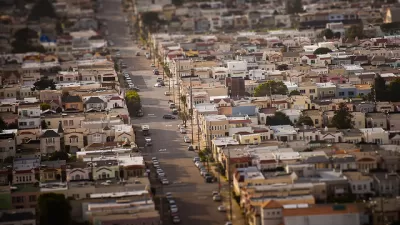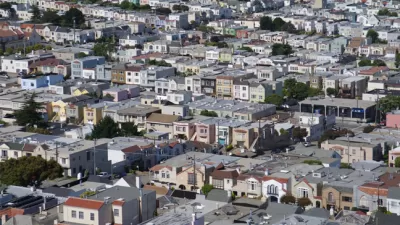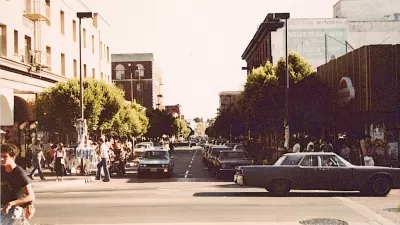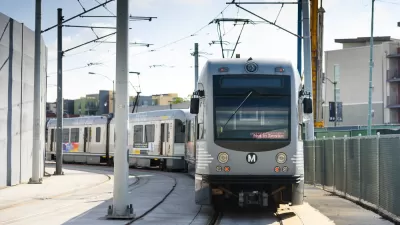Legislation from a former supervisor could transform much of San Francisco, particularly the outer-neighborhoods, by increasing heights and density along transit corridors. Opposition is growing.

"Senate Bill 827, authored by state Sen. Scott Wiener, D-San Francisco, could allow five- and eight-story buildings to sprout in neighborhoods that traditionally have seen mostly single-family homes and two-unit duplexes," reports Joe Fitzgerald Rodriguez for the San Francisco Examiner on February 18, 2018.
In San Francisco, where transit corridors with frequent buses and trains are numerous, “virtually the entire city” would be rezoned to allow taller residential buildings, according to an analysis [pdf] from the San Francisco Planning Department sent to planning commissioners on Feb. 5.
The Sunset, Richmond, Castro, Eureka Valley, Twin Peaks and more may see zoning changes to allow the rise of taller buildings. Even neighborhoods already zoned for taller buildings, like the Mission, would see an increase in density.
Rodriguez centers on the western neighborhood, the city's largest, known as the Sunset District. Hardware store owner and native San Franciscan, Albert Chow, is worried about the bill.
“The Sunset is the quiet suburban side of San Francisco," he states. But under the bill, Chow said, “The feel of the Sunset would be changed.”
Wiener, a former city supervisor, responds that other areas in the city have too long borne the brunt of new housing development.
“We have huge areas that get little or no density … We need density equity in San Francisco,” Wiener said.
The Planning Department is also concerned about how the bill links transit frequency with zoning and street widths with minimum building heights.
“Under the proposed bill, if an operator were to cut service from 15 minutes to 18 minutes, that would trigger a sudden rezoning for ¼-mile around the bus route," the Planning Department wrote.
As for street widths and building heights, the bill's text reads:
If the transit-rich housing project is within either a one-quarter mile radius of a high-quality transit corridor or within one block of a major transit stop, any maximum height limitation that is less than 85 feet, except in cases where a parcel facing a street that is less than 45 feet wide from curb to curb, in which case the maximum height shall not be less than 55 feet.
“The bill set up the unfortunate unintended consequence that property owners and developers would be inclined to oppose sidewalk widening since it could result in a significant downzoning,” notes the Planning Department.
Opposition grows in Los Angeles over displacement due to upzoning.
Local laws in Los Angeles, for instance, don’t offer the same robust tenant protections that exist in San Francisco, which prompted 37 housing and community nonprofits there, including the Central American Resource Center and the Koreatown Immigrant Workers Alliance, to sign an open letter opposing the bill.
As Wiener told the planning department, “Just to be very clear, the bill is a work in progress. We know it’s an aggressive bill.”
Wiener told the Examiner he is working “intensively” on anti-displacement language for the bill, including making it “crystal clear” the bill does not lessen local controls that discourage displacement of tenants leading to demolition of housing.
FULL STORY: Senate Bill 827 could raise height limits throughout SF, transform city

Study: Maui’s Plan to Convert Vacation Rentals to Long-Term Housing Could Cause Nearly $1 Billion Economic Loss
The plan would reduce visitor accommodation by 25,% resulting in 1,900 jobs lost.

Alabama: Trump Terminates Settlements for Black Communities Harmed By Raw Sewage
Trump deemed the landmark civil rights agreement “illegal DEI and environmental justice policy.”

Why Should We Subsidize Public Transportation?
Many public transit agencies face financial stress due to rising costs, declining fare revenue, and declining subsidies. Transit advocates must provide a strong business case for increasing public transit funding.

Paris Bike Boom Leads to Steep Drop in Air Pollution
The French city’s air quality has improved dramatically in the past 20 years, coinciding with a growth in cycling.

Why Housing Costs More to Build in California Than in Texas
Hard costs like labor and materials combined with ‘soft’ costs such as permitting make building in the San Francisco Bay Area almost three times as costly as in Texas cities.

San Diego County Sees a Rise in Urban Coyotes
San Diego County experiences a rise in urban coyotes, as sightings become prevalent throughout its urban neighbourhoods and surrounding areas.
Urban Design for Planners 1: Software Tools
This six-course series explores essential urban design concepts using open source software and equips planners with the tools they need to participate fully in the urban design process.
Planning for Universal Design
Learn the tools for implementing Universal Design in planning regulations.
Smith Gee Studio
Alamo Area Metropolitan Planning Organization
City of Santa Clarita
Institute for Housing and Urban Development Studies (IHS)
City of Grandview
Harvard GSD Executive Education
Toledo-Lucas County Plan Commissions
Salt Lake City
NYU Wagner Graduate School of Public Service





























